Grey Spotted Amanita / Summer / Autumn / Edible
Welcome to an exploration of nature’s beauty and the culinary delights of the Grey Spotted Amanita (Amanita excelsa).
Join us on a journey where caution and knowledge intersect. With its captivating grey cap and distinct spots, the Grey Spotted Amanita presents itself as an edible treasure.
However, it is crucial to recognize that it has a deadly toxic lookalike.
Learn to identify its unique features, understand its preferred habitats, and delve into the culinary wonders it offers. Through accurate identification and responsible foraging practices, we can safely enjoy the delicious flavors this mushroom provides. Respect for nature’s wisdom and informed awareness are essential in distinguishing the Grey Spotted Amanita from its toxic counterpart. Embrace the intricate wonders of nature as we celebrate the enchanting delights that lie within the Grey Spotted Amanita.
Get ready to embark on a flavor-filled journey, always ensuring your safety and well-being when identifying and consuming this remarkable mushroom.
Scientific Name
Amanita Excelsa
Common Names
Grey Spotted Amanita, False Panther Cap, Grey Warted Amanita.
Family
Amanitaceae
Habitat
They are mycorrhizal with quite a few different trees including, oak, birch, chestnut, spruce and pine. Most often found along the edges of woodlands.
Description
An edible member of the Amanita family but definitely not a beginners mushroom! Their lookalike is the Panther Cap (Amanita Pantherina) which is potentially deadly!
There are actually two variants of this mushroom, Amanita Excelsa variant excelsa and Amanita Excelsa variant spissa. Spissa is much more common in the UK and is slightly darker in colour. It’s more of interest to the mycologist rather than to the forager. We tend to treat them as one.
Identifying Features of the Grey Spotted Amanita:
Cap:
Domed when young the caps flatten out and sometimes become concave as they mature. They are grey/brown in colour and the surface is covered with the grey remains or fragments of their universal veil. These fragments can easily be brushed off or washed off by the rain so aren’t always present.
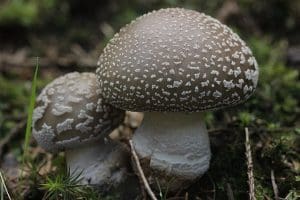
Stem:
They are fairly stout and white to off white in colour, with a robust ring or skirt towards the cap. The top of the ring is grooved, the grooves go up towards the gills. Above the ring the stem is smooth or gently striated, below the ring there are white scales. The stem is bulbous at the base rather than ended in a volva.
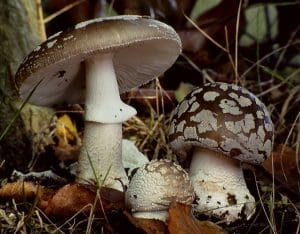
Gills:
The gills are white, fairly crowded and are free or very slightly adnexed.
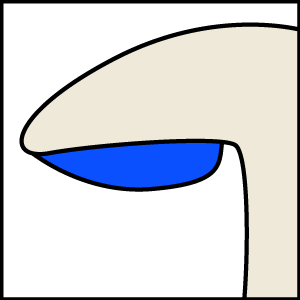
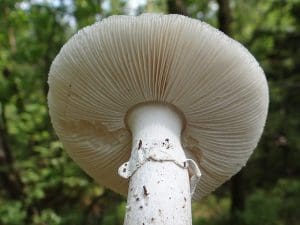
Smell:
Variant excelsa has a faint raddishy smell, variant spissa has an unpleasant smell.
Spores:
White.
Uses
In food
They must be thoroughly cooked before consumption. They do contain some toxins but these are destroyed by heat.
The taste and texture is pleasant but due to the risk of confusing them with deadly Amanitas, most likely the Panther Cap they’re not very often collected.
Harvesting
Not for the novice. Only experienced or stupid foragers collect ring-less Amanitas. The flavour is nothing particularly special so their best left alone.
Known hazards
They do contain some toxins so must be thoroughly cooked before consumption.
Potential lookalikes
They do look very similar in the Panther Cap (Amanita Pantherina) so should only be collected by experienced foragers. The Panther Cap has a smooth skirt and the veil that remains on the cap surface are white rather than grey.
The Blusher (Amanita Rubescens) could also look similar but its flesh bruises red. The Blusher is also edible.
Extra Notes
Excelsa is a Latin adjective that translates to elevated or lofty, in reference to their stature while Spissa means dense, in reference to the closely-spaced/crowded gills.



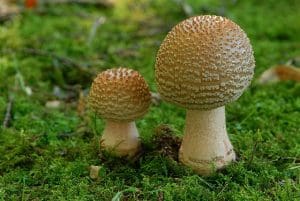



Leave a Reply
You must be logged in to post a comment.